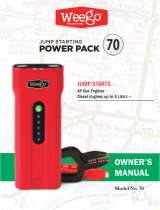
6
5. HEALTH & SAFETY INFORMATION
5.1 GENERAL SAFETY INSTRUCTIONS
WARNING: Please read the following instructions carefully, failure to do so could lead to serious
personal injury.
IMPORTANT: Draper Tools Limited recommends that this machine should not be modified or used for
any application other than that for which it was designed. If you are unsure of its relative applications do
not hesitate to contact us in writing and we will advise you.
WARNING - RISK OF EXPLOSIVE GASES
WORKING IN THE VICINITY OF A LEAD-ACID BATTERY IS DANGEROUS, BATTERIES GENERATE
EXPLOSIVE GASES DURING NORMAL BATTERY OPERATION. FOR THIS REASON, IT IS OF
UTMOST IMPORTANCE, IF YOU HAVE ANY DOUBT, THAT EACH TIME BEFORE USING THE
POWER PACK, YOU READ THIS MANUAL AND FOLLOW THE INSTRUCTIONS.
- To reduce risk of battery explosion, follow these instructions and those published by the battery
manufacturer and manufacturer of any equipment you intend to use in the vicinity of the battery.
Review warning marks on all these products and on the engine.
- When working near a lead-acid battery, someone should be within range of your voice, close enough
to come to your aid.
- Have plenty of fresh water and soap nearby in case battery acid contacts skin, clothing or eyes.
- Wear complete eye, hand and clothing protection. Avoid touching eyes when working with batteries.
- If battery acid contacts skin or clothing, wash immediately with soap and water. If acid enters eyes,
immediately flood eye with cool, clean running water for at least 15 minutes and get medical attention
immediately.
- NEVER smoke or allow a spark or flame in vicinity of battery or engine.
- Be extra cautious to reduce risk of dropping a metal tool onto a battery. It could spark or short circuit
the battery or, any other electrical part possibly causing an explosion.
- When working with a lead-acid battery, remove personal metallic items such as rings, bracelets,
necklaces and watches. A lead-acid battery can produce a short-circuit current high enough to weld a
ring, or the like to metal, which may cause severe burns.
- Use the battery charger for charging “lead-acid batteries only”. Do not use for charging dry-cell or
Ni-Cad batteries that are commonly used with home appliances. For example, radios, torches etc.
These batteries may explode and cause injury to persons and damage to property.
- NEVER charge or boost a frozen battery.
- NEVER allow clamps to touch one another or to contact the same piece of metal to prevent arcing.
- Ensure the power pack is switched off prior to connecting/disconnecting of the vehicle battery.
- Do not use the charger in damp or wet conditions.
- Keep out of reach of children.
- Do not submerge in water.
- Do not operate near flammables such as petrol, paraffin, or thinners etc.
If the charger receives a sharp blow or is otherwise damaged in any way, do not disassemble. Have it
checked by a qualified service person. Return to source.
- The battery must be removed from the appliance before it is scrapped.
- The appliance must be disconnected from the supply mains when removing the battery.
- The battery must be disposed of safely.
- This appliance is for use on 12V circuits only.
- Do not use in high temperatures.
- Before connecting the power pack, ensure the main switch is in the ‘off’ position.
- If incorrect polarity is indicated, disconnect immediately and rectify.
- Prior to initial use charge for 24 hours.
- Do not use the power pack while charging.




















